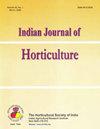基于 CGMS 的辣椒 F1 代杂交种形态、果实质量和产量性状评价
Q4 Agricultural and Biological Sciences
引用次数: 0
摘要
辣椒是一种重要的蔬菜兼香料作物,在食品、植物饲料、化妆品和制药行业有着广泛的应用。为了满足需求,有必要培育出耐受/抵抗主要威胁性病害、产量更高的 F1 代杂交种。本研究旨在研究 13 个基于 CGMS 的高产 F1 代杂交种的形态、果实品质和产量性状的多样性及其对辣椒卷叶病的反应。杂交种 Arka Nihira、Arka Yashasvi、H-25、H-26 和 Arka Tanvi 在大多数增产性状方面表现优异。这些杂交种的增产潜力归因于高形态计量和果实生物计量。与当地对照(HPH-3351)相比,杂交种 Arka Nihira 的青果产量提高了约 62%。聚类图将这些杂交种分为四个主要组,揭示了杂交种之间的遗传相似性和差异。此外,一项性状关联研究表明,在辣椒育种计划中选择商业杂交栽培品种时,可以利用50%开花天数、植株展开度、果实产量和单株果实数等性状作为青果产量的间接选择指标。特别是杂交种 Arka Nihira 和 Arka Tanvi,在印度德干高原的浅玄武岩土壤中,在产量、农艺特性和叶卷叶病耐受性方面具有成为商业栽培品种的潜力。本文章由计算机程序翻译,如有差异,请以英文原文为准。
Evaluation of CGMS-based chilli F1 hybrids for morphometric, fruit quality and yield traits
Chilli is a significant vegetable cum spice crop having broader applications in the food, phytogenic feed,cosmeceutical and pharmaceutical industries. To meet the demand, there is a need to develop F1 hybrids withtolerance/ resistance to major threatening diseases and higher yields. The present investigation was conductedto study the diversity of morphometric, fruit quality and yield traits and their reaction to chilli leaf curl diseaseamong thirteen CGMS-based high-yielding F1 hybrids. The hybrids Arka Nihira, Arka Yashasvi, H-25, H-26, andArka Tanvi excelled for most of the traits contributing to yield enhancement. The yield increment potential inthese hybrids is attributed to high morphometric and fruit biometric. In relation to the local check (HPH-3351),hybrid Arka Nihira exhibited enhanced green fruit yield by about sixty-two per cent. The cluster plot partitionedthese hybrids into four primary groups, revealing genetic similarities and differences among the hybrids. Further,a character association study indicates that traits such as days to 50 per cent flowering, plant spread, fruitgirth, and the number of fruits per plant can be leveraged as indirect selection indices for green fruit yield whileselecting a commercial hybrid cultivar in chilli breeding programs. The hybrids, Arka Nihira and Arka Tanvi, inparticular, have the potential to be commercial cultivars in terms of yield, agronomic characteristics, and leafcurl disease tolerance in shallow basaltic soils of the Deccan plateau of Indi
求助全文
通过发布文献求助,成功后即可免费获取论文全文。
去求助
来源期刊

Indian Journal of Horticulture
农林科学-园艺
CiteScore
0.50
自引率
0.00%
发文量
22
审稿时长
4-8 weeks
期刊介绍:
Information not localized
 求助内容:
求助内容: 应助结果提醒方式:
应助结果提醒方式:


